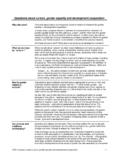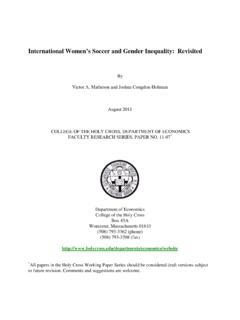Transcription of PUBLISHED TO PROMOTE THE GOALS OF THE BEIJING …
1 UNITED NATIONS Division for the Advancement of Women Department of Economic and Social AffairsEdwina SandysDecember 2007 Women, gender equality and sportPUBLISHED TO PROMOTE THE GOALS OF THE BEIJING DECLARATION AND THE PLATFORM FOR ACTION women2000 and beyond December 20072 Introduction Bicycling has done more to emancipate women than any one thing in the world Susan B. Anthony, suffragist, 1896 Women s participation in sport has a long history. It is a history marked by division and discrimination but also one filled with major accomplishments by female athletes and important advances for gender equality and the empower-ment of women and girls.
2 Among the many remarkable achievements are those of Helene Madison of the United States of America, the first woman to swim the 100-yard freestyle in one minute at the 1932 Olympics; Maria-Teresa de Filippis of Italy, the first woman to compete in a European Grand Prix auto race in 1958; Nawal El Moutawakel of Morocco, the first woman from an Islamic nation to win an Olympic medal for the 400 -metre hurdles at the 1984 Olympics; and Tegla Loroupe of Kenya, who in 1994 became the first African woman to win a major Women have taken up top leadership positions in sport, such as Presidents and Secretaries-General of National Olympic Committees.
3 More and more women have also taken up employment opportunities in all areas of sport, including as coaches, manag-ers, officials and sport journalists. These achievements were made in the face of numerous barriers based on gender discrimination. Women were often perceived as being too weak for sport, particularly endurance sports , such as marathons, weightlifting and cycling, and it was often argued in the past that sport was harmful to wom-en s health, particularly their repro-ductive health. In 1896, Baron Pierre de Coubertin, founder of the modern Olympics, stated: No matter how toughened a sportswoman may be, her organism is not cut out to sustain certain shocks.
4 2 Such stereotypes fuelled gender -based discrimination in physical education and in recreational and competitive sport, sporting organi-zations and sport media. The benefits for women and girls of physical activity and sportAlthough many of the clinical trials and epidemiological studies in health research have excluded women, the data available suggest that women derive many health benefits from an active The health benefits of women s participation in physical activ-ity and sport are now well established.
5 Participation in sport and physical activ-ity can prevent a myriad of noncom-municable diseases which account for over 60 per cent of global deaths, 66 per cent of which occur in develop-ing For girls, it can have a positive impact on childhood health, as well as reduce the risk of chronic dis-eases in later older women, it can contribute to the prevention of cardiovascular dis-eases, which account for one third of deaths among women around the world and half of all deaths among women over 50 in developing Physi-cal activity also helps to reduce the effects of osteoporosis, which women have a higher risk of developing than Participation in physical activity aids in the prevention and/or treatment of other chronic and degenerative dis-eases associated with aging, such as type-2 diabetes, hypertension, arthritis, osteoporosis and cardiovascular abnor-malities.
6 It also helps in the manage-ment of weight and contributes to the formation and maintenance of healthy bones, muscles and joints. Physical activity can reduce the incidence of falls among older women. An important role of physical activ-ity in the life of older women lies in prolonging independence. Much of the physical decline that was presumed an inevitable consequence of aging is now thought to be the result of inactivity. While no one can guarantee that exer-cise will prolong life, it can enhance the quality of life for older women who value their benefits for women and girls with disabilities are also well estab-lished.
7 It has been noted that sport provides a double benefit to women with disabilities by providing affirma-tions of self-empowerment at both personal and collective Apart from enhancing health, wellness and quality of life, participation in physical activity and sport develops skills such as teamwork, goal-setting, the pursuit of excellence in performance and other achievement-oriented behaviours that women and girls with disabilities may not be exposed to in other Participation in sport and physical activity can also facilitate good mental health for women of all ages, includ-ing the management of mental disor-ders such as Alzheimer s It can PROMOTE psychological well-being through building self-esteem, confi-dence and social integration, as well as help reduce stress, anxiety, loneli-ness and depression.
8 This is particu-larly important as rates of depression among women are almost double those of men in both developed and developing Adolescent girls in particular are vulnerable to anxi-ety and depressive disorders and are significantly more likely than boys to Women, gender equality and sportDecember 2007 women2000 and beyond have seriously considered suicide by the age of In addition to improvements in health, women and girls stand to gain specific social benefits from partici-pation in sport and physical activity.
9 Sport provides women and girls with an alternative avenue for participation in the social and cultural life of their communities and promotes enjoyment of freedom of expression, interper-sonal networks, new opportunities and increased self-esteem. It also expands opportunities for education and for the development of a range of essential life skills, including communication, leader-ship, teamwork and negotiation. Inactive adults can rapidly improve their health and well-being by becom-ing moderately active on a regular basis.
10 Physical activity need not be strenuous to achieve health benefits and it is never too late to gain benefits of women s participation for sport and societyIn addition to benefits for women and girls themselves, women s increased involvement can PROMOTE positive development in sport by providing alter-native norms, values, attitudes, know-ledge, capabilities and experiences. The contributions of women, particu-larly in leadership positions, can bring diversity and alternative approaches and expand the talent base in areas such as management, coaching and sport journalism.



















